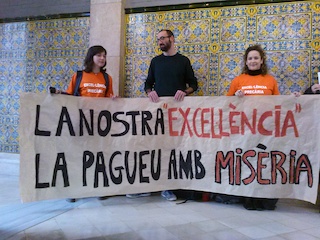You have /5 articles left.
Sign up for a free account or log in.

A few weeks ago I was invited to present Paying the Professoriate, a comparative study of academic salaries, to ACUP, the Catalan Association of Public Universities in Barcelona. I had been a collaborator on this project while at the Center for international Higher Education at Boston College. As soon as we arrived, we confronted a group of people wearing orange T-shirts printed with “Excel·lència Precária” (Precarious Excellence). Many of them were also holding banners alluding to their situation, one said “La Nostra ‘Excel·lència’ la pagueu amb misèria" (Our ‘excellence’ paid with misery”). They were university professors. Most, if not all of them, had PhDs and were hired as postdocs, adjuncts, part-time, or untenured professors with fix-term contracts.
During a press conference, Josep Villalta, ACUP’s Secretary General, confirmed what the protesters were expressing: half of the professors in Catalonia earn between €300 (associate professors) and €1,200 (post-docs) per month (US $409 and $1,637, respectively). The situation is complicated by the fact that associate professors (by law) are only allowed to teach part-time. In contrast, professors with more stable positions (catedráticos, titulares-agregados and lectores) earn salaries that are competitive in the European Union. The Spanish newspaper El País also brought to attention this problem noting that for many professors finding a job abroad is a better option. One person quoted remarked that academic salaries in Spain were lower than those offered by universities in Ecuador.
Why the relevance of Ecuador? Because the Ecuadorian Government announced the goal of hiring 500 professors, initially for the Universidad Nacional de Educación (National Teaching University, UNAE) in Azogues with plans to expand this initiative to six other cities. The goal is to hire 5,000 additional professors including part-time, fulltime, and short-term appointments, in the next five years. Monthly salaries will be between US $2,226 and $5,009, depending on the professor’s rank and credentials. Benefits will include a housing subsidy, transportation, and meals at the workplace.
Colombia has launched a call to the diaspora in an effort to return brain drain. In the first stage of the program, Colciencias (the government’s scientific research agency) hopes to attract 72 high-level researchers back to local universities. The package includes a two-year contract with a monthly salary of US $3,000, tax exemptions, subsidies to buy a house and car, a research grant of up to $75,000, travel expenses, a relocation bonus of approximately $5,000, and a bonus of $32,000 paid only once for furniture and other resettling expenses. The total cost of the initiative for the country is estimated around US $5.6 million. In Colombia a comparable offer was made only once before, thirty years ago, by president Belisario Betancur, with similar objectives and limited success.
Despite the efforts of the Colombian government, this initiative may not be competitive in an international context. A $3,000 monthly salary might be attractive to most Colombians, but it may not be very attractive to an international recruit. The average full-professor (Profesor Titular) can achieve a similar salary working for a research university in Colombia. Yet, they have to pay taxes, contribute to health insurance and retirement funds and would not receive any of the bonuses offered to the international recruits. According to the Colombian Observatory of Labor Market, the average entry-level salary for a person with a doctoral degree in Colombia is US $2,735, just a little lower than the amount offered by Colciencias to attract top-level researchers. At the international level, the figures are even less competitive. The annual entry salary for an assistant professor in a public university in the US was estimated in $ 68,072 (roughly $5,672 monthly). The government's initiative was officially launched in Boston, in front of a group of Colombian students and graduates from Harvard, MIT, and other top universities of the Boston Area where full-time tenure-track jobs are increasingly scarce and more competitive and, as in most of the world, the proportion of adjunct faculty and part-timers is growing at a very fast pace.
There are important differences between the strategies of Colombia and Ecuador. Ecuador is offering competitive salaries to both expatriots and international professors (mostly from Spain) who are not happy with their current remuneration or future prospects, while Colombia is trying to attract high-level Colombian scientists back from the diaspora offering salaries that while they may not be competitive at an international level, are attractive in the national context,. The Ecuadorian offer is tempting for many Spanish professors because academic positions are scarce at home and not very well paid. The Colombian proposal is targeted at scientists who are already immersed within international academic communities, something that most of them value as much as salary and may not be very inclined to forego. Time will show the effectiveness of each strategy.
Other middle-income economies are trying to strengthen their academic and research communities but they compete in a tough market. One example that merits another blog post is the case of PAIR (Programa Académico Internacional Regular) launched by the Universidad Autónoma de Chile targeting national and international faculty, that has attracted at least a hundred professors from Spain. The demand for qualified professors and researchers in middle-income economies will continue to grow as these countries and their universities try to catch-up with the developed world. Still, industrialized countries will keep the lion’s share of talent when it comes to attracting and retaining faculty. However, the fast pace at which some developed countries are graduating masters and doctors, and the slow pace at which some of them absorb those graduates may open a window of opportunity from which middle-income economies, if they act fast and wisely, may take some advantage. It may not be the end of brain drain, but for some countries, this may be an opportunity for some brain-gain.

